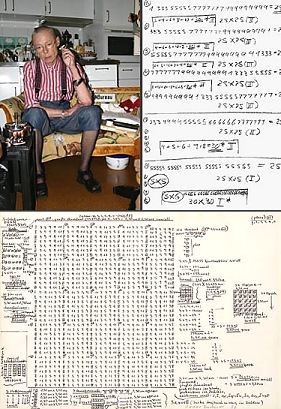Steve’s click picks #11
Our regular listen to and look at living, breathing composers and performers that you may not know yet, but I know you should… And can, right here and now, since they’re nice enough to offer so much good listening online:
Hanne Darboven (b. 1941 — DE)

What better way to mark a new year than with something that is only and utterly about time, history and the march of events (or their stubborn recurrence)!
Only one piece to listen to, but it’s a full hour-plus. Darboven’s Opus17a for solo double bass was composed in 1996 for her massive artwork “Kulturgeschichte 1880–1983”, shown at the Dia Center for the Arts in New York. Played here with almost superhuman concentration and doggedness by Robert Black, it’s a piece guaranteed to either absolutely fascinate, repel or bore you to tears, depending on who you are.
The artist Hanne Darboven was born in Munich. Following a brief episode as a pianist, she studied painting in Hamburg. Between 1966 and 1969 she lived intermittently in New York City, then returned to her family home in Hamburg, where she continues to live and work.
Why and how does a visual artist turn to musical composition? The progression makes perfect sense as described in the essay by Lynne Cooke:
…[Darboven’s] work has been informed by Conceptual art practices. Based by the late 1960s on various forms of numerical writing, her systematic work securely occupied the realm of abstraction and universality.
“I only use numbers because it is a way of writing without describing. . . . It has nothing to do with mathematics. Nothing! I choose numbers because they are so constant, confined, and artistic. Numbers are probably the only real discovery of mankind. A number of something (two chairs, or whatever) is something else. It’s not pure number and has other meanings.”
Time has become the focus of Darboven’s art. For her, Annelie Pohlen argues, time constitutes the primary and essential structure of human life — it is “a basically intangible measure for the totality of the indices determining being; it is the content of consciousness; it exists beyond human comprehension.” The calendar, which subsequently formed the foundation of Darboven’s art practice, again offered a universal orientation, embodying a given, prefabricated, ready-made temporal system. Calibrated in her work in many ways over almost three decades, it has provided the basis of an arbitrary artistic system that has the appearance of objectivity. Conjoining a rigorous numerical process with free-associative roots, and tight rational thought with intellectual freedom, Darboven’s capricious sense of time has resulted in diverse monumental works that may span a month, a year, even a century, all recorded day by day.
In the early 1970s Darboven introduced a kind of writing into her work that took the form of an even cursive script. Although executed by hand, this script was standardized and regulated, systematic and abstract. […] In 1973 she began to incorporate texts—transcribed directly because, she has claimed, they could not be bettered— from various writers, initially Heinrich Heine and Jean-Paul Sartre. These texts spoke both to her recognition of the failure of the grand narratives of Enlightenment thought to provide convincing, encompassing interpretations and, equally, to her fundamentally romantic existentialist position. Then, in 1978, she introduced visual documentation alongside her numbers and looping texts, primarily in the form of found and rephotographed images, which allowed her to address specific historical issues for the first time. Shortly thereafter, she invented a system of musical notation, based on her system of numbering dates, which she has used since 1979 to compose scores for organ, double bass, string quartet, and chamber orchestra. Darboven sees her music as she does her “mathematical writing,” a highly abstract language functioning in an entirely self-referential manner; it thus serves as an abstract correlative to the concrete, visual nature of her artwork.
Darboven’s up somewhere past Op. 60 or so; some other things are on CD, but most isn’t. One thing I’d love to see reissued in a CD edition would be the recordings that were made of Op.1-6b, that were part of the work “Wende ’80”. It was put out on 11 (!) LPs around 1986:
http://www.hamburger-kunsthalle.de/sammlungav/html_sammlung/d/darboven_1982_86.html
this is really great. thank you. ubu.com is one of my new finds, there are so many amazing resources there. i definitely encourage everyone to check out kenneth goldsmith’s “the weather” … which i found through ubu a couple weeks ago, very inspiring.